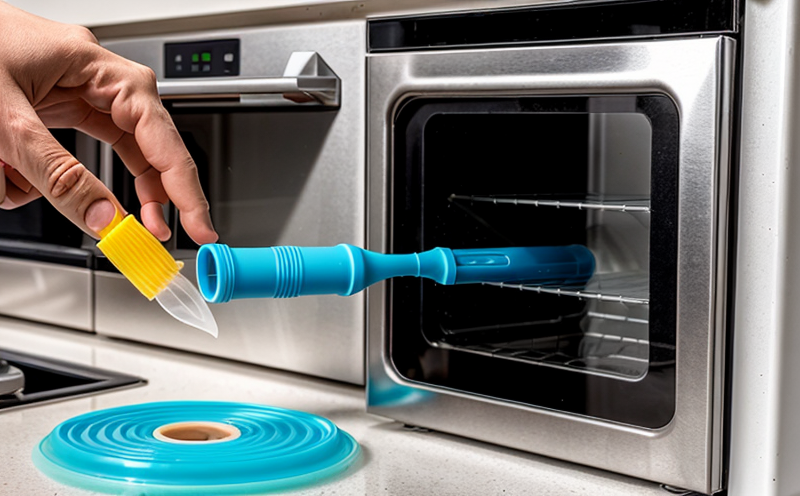ASTM G154 UV Resistance Testing of Household Plastics
The ASTM G154 standard is a widely recognized method used to evaluate the resistance of materials, including household plastics, to ultraviolet (UV) radiation. This test simulates exposure to sunlight and helps manufacturers ensure their products maintain integrity over time under real-world conditions.
Household plastics are often exposed to UV light during use, especially those that are left outdoors or in areas with high levels of natural sunlight. These materials can include items like outdoor furniture, toys, packaging films, and other consumer goods. Understanding how these materials will perform under prolonged UV exposure is critical for quality assurance.
The ASTM G154 test uses two types of artificial light sources: xenon arc lamps (Xe) and fluorescent UV lamps (UV-A). Xenon lamps provide a broad spectrum of radiation that mimics the sun's rays, while UV lamps focus on simulating the UV component specifically. The exposure time can range from 80 to 120 hours, depending on the desired level of aging.
Specimen preparation is crucial for accurate testing results. Samples need to be cut into standard sizes and shapes that are representative of the product's real-world usage. This ensures consistent testing across different samples. The specimens are then exposed to UV light in a controlled environment, monitored at specific intervals, and evaluated for changes over time.
The ASTM G154 test is essential for several reasons:
- It helps manufacturers identify potential weaknesses in their products' design or formulation.
- It ensures compliance with industry standards and regulations.
- It provides valuable data that can be used to improve product durability and performance.
The test results are typically reported as the weight loss, color change, or mechanical property changes observed in the specimens after exposure. These metrics help determine the UV resistance of the materials and guide improvements where necessary.
In conclusion, ASTM G154 UV Resistance Testing is a vital tool for quality managers, compliance officers, R&D engineers, and procurement professionals working with household plastics. By ensuring products can withstand UV radiation, manufacturers can enhance product longevity and customer satisfaction while adhering to industry standards.
Why It Matters
The durability and appearance of household plastics are crucial factors for consumer satisfaction. Exposure to UV light can lead to degradation over time, resulting in color fading, cracking, or loss of physical properties. ASTM G154 testing ensures that the materials used meet industry standards and provide long-term performance.
Manufacturers who conduct this test can:
- Avoid product recalls due to early failure.
- Meet regulatory requirements related to material safety and durability.
- Demonstrate compliance with international standards such as ASTM G154.
The results of the test are significant for several reasons:
- Consumer Trust: Products that pass UV resistance tests are more likely to be trusted by consumers, leading to increased brand loyalty and sales.
- Sustainability: Materials that resist UV radiation better contribute to the overall sustainability of products by reducing waste.
- Competitive Advantage: Companies that invest in quality assurance through testing like ASTM G154 can differentiate themselves from competitors offering less durable or less reliable products.
By understanding and addressing potential weaknesses early in the product development process, manufacturers can significantly enhance their products' performance and longevity. This is particularly important for household items where prolonged exposure to sunlight is common.
Quality and Reliability Assurance
The ASTM G154 UV Resistance Testing provides a robust framework for quality assurance in the manufacturing of household plastics. By subjecting samples to controlled UV radiation, manufacturers can identify potential issues before products reach the market. This allows for timely adjustments and improvements, ensuring that final products meet or exceed industry standards.
Quality managers rely on this testing method because it:
- Provides objective data for decision-making.
- Ensures consistency across different batches of materials.
- Allows for the identification and elimination of defects early in the production process.
The test results are critical for maintaining high standards of quality and reliability. They provide a clear picture of how well materials will perform under real-world conditions, which is essential for product design and development.
Compliance officers also benefit from this testing method as it helps ensure that products meet all relevant regulatory requirements. By using ASTM G154, companies can demonstrate their commitment to quality and reliability, thereby enhancing their reputation in the market.
Environmental and Sustainability Contributions
The durability of household plastics plays a significant role in environmental sustainability. Products that resist UV degradation for longer periods contribute positively to waste management efforts by reducing the frequency with which replacement products are needed. This not only helps minimize landfill contributions but also supports recycling programs, as materials remain viable for longer.
By ensuring that household plastics pass ASTM G154 UV Resistance Testing, manufacturers can:
- Reduce waste and improve resource efficiency.
- Promote the circular economy by extending product lifecycles.
- Contribute to global sustainability goals set forth by international organizations like ISO and IEC.
The use of sustainable materials is increasingly important in today's market. ASTM G154 helps manufacturers evaluate their materials' performance, ensuring they are both durable and environmentally friendly. This dual approach supports broader efforts towards reducing the environmental impact of consumer goods.
Additionally, by conducting this test, companies can contribute to a more responsible supply chain. Ensuring that suppliers deliver high-quality materials is crucial for maintaining product integrity and sustainability throughout the entire lifecycle of household plastics.





